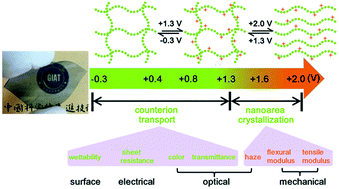Green full polymer flexible transparent electrodes showing versatile switching behaviors based on either counterion transport or nanoarea crystallization†
Abstract
To address the demand of smart flexible electronics in high-end applications, a green intelligent full polymer flexible transparent electrode (FPFTE) is developed by ultraviolet (UV)-printing with solvent-free ink. FPFTEs, comprising conducting polymers based on two types of thiophene derivatives (3,4-ethylenedioxythiophene and custom-synthesized 1-(perfluorophenyl)-2,5-di(thiophen-2-yl)-1H-pyrrole) used as an intelligent medium and polyacrylates with an average functionality of 3.3, feature “green” credentials, that is, low cost, environmentally friendly nature, scalable production and problem-free adhesion. UV-printing involves a formation process for the full polymers by simultaneous initiation of cationic polymerization of the thiophene derivatives and free radical polymerization of the acrylates. In response to periodic electrical stimuli, the FPFTEs show versatile switching behaviors for the surface, electrical, optical and mechanical properties due to two independent stages of reversible changes of either counterion transport or nanoarea crystallization. Further, through the manipulation of the switching behaviors, the integration of FPFTEs into smart flexible electronic devices is demonstrated to be practical and reliable. The green FPFTEs showing counterion transport and nanoarea crystallization-mediated switching behaviors can advance the development of intelligent materials from the macroscopic to microcosmic scales.



 Please wait while we load your content...
Please wait while we load your content...